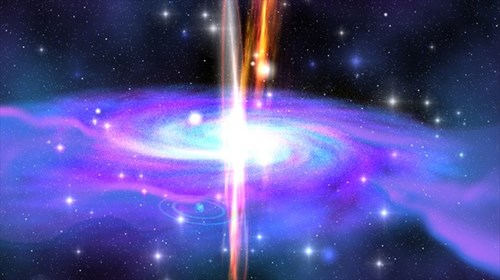Detecting a strange stream of gamma rays in the universe
The Fermi Space Telescope of NASA has discovered a strange stream of gamma rays in the universe. Scientists think they could help reveal many mysteries about antimatter, RT reported.
NASA discovered a strange stream of gamma rays in the universe
When they uncovered the veil of antimatter , scientists believe that they will help people answer a difficult question, why the universe exists so much of material rather than antimatter.

Gamma rays - (Artwork: Shutterstock)
This question has long been a headache for scientists. They believe that the universe formed after the Big Bang . At that time, matter and antimatter have equal numbers. Antimatter is a form of opposition to matter. In theory, these two types of interaction will explode and release a lot of energy.
However, for some reason they did not interact and explode. The level of human science is still unable to explain this.The matter then overwhelms antimatter , which appears throughout the universe and from there life is formed.
Recently, the physics professor of Vachaspati Tanmay at Arizona State University (USA) and colleagues have found clues to this mysterious question. With the Fermi space telescope , they discovered a vortex of gamma rays , high-energy light, and thought it originated when the new universe was born.

Fermi space telescope - (Artwork, taken from RT screen)
Analyzing gamma rays, they found them swirling from right to left. This is evidence that the antimatter material is overwhelmed. If the antimatter is stronger, these rays will rotate in the opposite direction from left to right.
Scientists expect new discoveries with the collection of more data that Fermi will collect to help track what has helped material overwhelm antimatter, thereby forming planets , celestial and appearance of life.
The Fermi space telescope was launched by NASA in 2008, with the task of collecting gamma rays originating in remote places of the universe, including supermassive black holes .
- Learn about gamma rays and gamma flashes
- Gamma rays are difficult to explain in the universe
- Gamma rays carry super energy coming from the other side of the universe
- Decoding the mysterious ray of Dr. Vu Van Bang
- Fireworks from a gamma ray star
- Detecting a strange explosion in a distant galaxy
- Super energy gamma beam
- The Fermi telescope 'captured' dark matter
- If your eyes are sharp, you'll see that the Moon is brighter than the Sun.
- Strange stream in China: The temperature is -43.5 degrees Celsius, the water is still not frozen
- The mysterious circle is the largest 5 billion light-years from the universe
- Celestial body is the brightest invisible universe before the naked eye
 Van Allen's belt and evidence that the Apollo 11 mission to the Moon was myth
Van Allen's belt and evidence that the Apollo 11 mission to the Moon was myth The levels of civilization in the universe (Kardashev scale)
The levels of civilization in the universe (Kardashev scale) Today Mars, the sun and the Earth are aligned
Today Mars, the sun and the Earth are aligned The Amazon owner announced a secret plan to build a space base for thousands of people
The Amazon owner announced a secret plan to build a space base for thousands of people